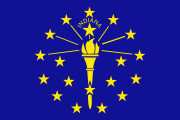Muncie, Indiana
| City of Muncie, Indiana | |
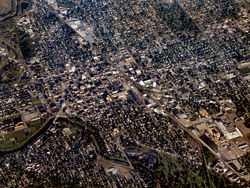 |
|
| Nickname(s): Middletown USA | |
 |
|
| Coordinates: | |
| Country | United States |
|---|---|
| State | Indiana |
| County | Delaware |
| Township | Center |
| Government | |
| - Mayor | Sharon McShurley (R) |
| Area | |
| - Total | 24.2 sq mi (62.7 km²) |
| - Land | 24.2 sq mi (62.6 km²) |
| - Water | 0.0 sq mi (0.0 km²) |
| Elevation | 932 ft (284 m) |
| Population (2000) | |
| - Total | 65,287 |
| - Density | 2,788.6/sq mi (1,076.7/km²) |
| Time zone | EST (UTC-5) |
| - Summer (DST) | EDT (UTC-4) |
| ZIP codes | 47302-47308 |
| Area code(s) | 765 |
| FIPS code | 18-51876[1] |
| GNIS feature ID | 0439878[2] |
| Website: www.cityofmuncie.com | |
Muncie (pronounced /ˈmʌnsi/) is a city in Center Township, Delaware County in east central Indiana, best known as the home of Ball State University and the birthplace of the Ball Corporation. It is the principal city of the Muncie, Indiana Metropolitan Statistical Area, which has a population of 118,769. The population within city limits, as of a 2006 Census estimate, was 65,287.[3]
Contents |
History
The area was first settled in the 1770s by the Delaware Indians, who had been transported from their tribal lands near the east coast to Ohio and eastern Indiana. They founded several towns along the White River including Muncietown, near the site of present-day Muncie. The tribes were forced to cede their land to the federal government and move further west in 1818, and in 1820 the area was opened to white settlers. Muncie was one of the considerations for state capital when it was moved from Corydon. It was considered by many to be a suitable location due to its location on the White River. The city of Muncie was incorporated in 1865. Contrary to popular legend, the city is not named after a mythological Chief Munsee, rather it was named after Munsee Town, the white settlers' name for the Indian village on the site.
Muncie was dubbed Middletown after a team of sociologists, led by Robert Lynd and Helen Lynd, initiated a series of sociological studies in Muncie funded by the Rockefeller Institute of Social and Religious Research. "The aim... was to study synchronously the interwoven trends that are the life of a small American city." (Lynd and Lynd 1929: 3) Muncie was considered a typical Middle-American community. In 1929, the Lynds published their first study in a book entitled Middletown: A Study in Modern American Culture. The Lynds returned to Muncie to re-observe the community during the depression. In 1937 they published Middletown in Transition: A Study in Cultural Conflicts. The National Science Foundation then funded a third study resulting in two books by Theodore Caplow, Middletown Families (1982) and All Faithful People (1983). Caplow returned in 1998 to begin another study known as Middletown IV, which became part of a PBS Documentary entitled "The First Measured Century," released in December, 2000. These are only a few of the most notable studies. The Ball State Center for Middletown Studies continues to survey and analyze the social changes occurring in Muncie. An enormous database of Middletown surveys, conducted from 1978 to 1997, is available online from ARDA, American Religion Data Archive. Ironically, a Henry County farming community with the authentic name of Middletown, IN, is only a 20-minute drive from Muncie, though it has no relationship to the Middletown Studies.
- See also Middletown studies
Demographics
As of the 2006 census estimate, there were 65,287 people living in Muncie. As of the 2000 census, there were 27,322 households, and 14,589 families residing in the city. The population density was 2,788.2 people per square mile (1,076.7/km²). There were 30,205 housing units at an average density of 1,248.9/sq mi (482.3/km²). The racial makeup of the city was 83.72% White, 12.97% African American, 0.27% Native American, 0.79% Asian, 0.09% Pacific Islander, 0.67% from other races, and 1.49% from two or more races. Hispanic or Latino of any race were 1.44% of the population.
There were 27,322 households out of which 23.7% had children under the age of 18 living with them, 36.4% were married couples living together, 13.0% had a female householder with no husband present, and 46.6% were non-families. 34.1% of all households were made up of individuals and 11.8% had someone living alone who was 65 years of age or older. The average household size was 2.24 and the average family size was 2.86.
In the city the population was spread out with 19.8% under the age of 18, 24.6% from 18 to 24, 24.2% from 25 to 44, 18.3% from 45 to 64, and 13.2% who were 65 years of age or older. The median age was 29 years. For every 100 females there were 89.9 males. For every 100 females age 18 and over, there were 86.5 males.
The median income for a household in the city was $26,613, and the median income for a family was $36,398. Males had a median income of $30,445 versus $21,872 for females. The per capita income for the city was $15,814. About 14.3% of families and 23.1% of the population were below the poverty line, including 24.2% of those under age 18 and 9.7% of those age 65 or over.
Economy
Since the late 19th century, Muncie’s economic backbone had been the in the industrial sector, primarily in manufacturing. Notable factories that employed a sizable amount of the population include Delco Remy, Westinghouse (later ABB), Indiana Steel and Wire, General Motors (New Venture Gear), Warner Gear (later BorgWarner), Broderick Co. Inc., Dayton-Walter, and Ball Corporation. However, most of these factories closed during a tumultuous period for the city from the late 1980s and late 1990s. As of 2006, the only aforementioned factory/corporation still in business (or at least operating in Muncie) was BorgWarner Inc. which is slated to close by 2009. However, smaller, non-unionized manufacturing businesses have survived this transition such as Maxon Corporation, Duffy Tool, and a dozen or so other shops that employ anywhere from a few dozen to a couple of hundred workers.
Like many mid-sized cities in the rust belt, Muncie has had to economically reinvent itself due to the collective fall of the manufacturing industry in the latter part of the 20th century. Muncie’s current economic backbone is in the health care, educational, and human resources, and service industries. The largest employers in Muncie are Ball Memorial Hospital/Cardinal Health Services, Ball State University, Muncie Community Schools, The City of Muncie, Sallie Mae, and Wal-mart. The local economy is one of the most controversial topics for Muncie residents, and the city has at times struggled to find cohesion between older unemployed/underemployed Muncie residents who strongly identify with the manufacturing history of the town, and newer residents who identify with the educational, health care and other white-collar industries. Muncie is clearly in a state of economic and social transition, but has experienced moderate economic growth in recent years despite continuing to lose population.
Education
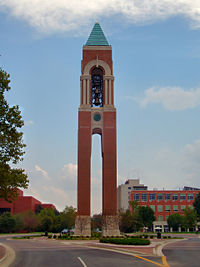
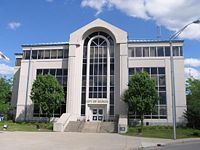
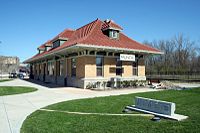
Elementary schools
- Burris Laboratory School
- Garfield Elementary
- South View Elementary
- Grissom Elementary
- Storer Elementary
- Longfellow Elementary
- Sutton Elementary
- Mitchell Elementary
- North View Elementary
- West View Elementary
- Hoosier Academy Muncie
Middle schools
- Burris Laboratory School
- Northside Middle School
- Wilson Middle School
- Hoosier Academy Muncie
High schools
- Burris Laboratory School
- Delta High School
- Indiana Academy for Science, Mathematics, and Humanities
- Muncie Central High School
- Muncie Southside High School
For other Delaware County high schools, click here.
Colleges and universities
- Ball State University
- Ivy Tech State College
- Indiana Business College
Notable natives & residents
See also Category:People from Muncie, Indiana.
General
- Michelle Baena, Playboy model
- Ball Brothers, founders of the Ball Corporation, originally a producer of glass canning jars but now a producer of various products.
- Benjamin V. Cohen - a key figure in the administrations of Presidents Franklin D. Roosevelt and Harry S. Truman.
- George R. Dale, editor of the Muncie Post-Democrat (1920-1936) who gained national attention by speaking out against the Ku Klux Klan.[4]
- Bertha Fry - At the time of her death on November 14, 2007, the 3rd oldest person living on earth at 113 years.[5]
- Timothy Groeling[6] - Author and University of California, Los Angeles Professor of Communications and New Media.
- David Letterman, former student at Ball State University, talk show icon, host of Late Show With David Letterman
- Gregory Howard Williams, dean of the Ohio State University School of Law and author of Life on the Color Line: The True Story of a White Boy Who Discovered He Was Black.
Arts
- Ray Boltz - singer, Contemporary Christian musical artist [7]
- Everett Bradley[8] - Musician (solo, w/Bon Jovi, David Bowie), actor
- Mary Jane Croft - Actress; appeared in The Adventures of Ozzie and Harriet, I Love Lucy as "Betty Ramsey", and The Lucy Show and Here's Lucy as Mary Jane Lewis [9]
- Jim Davis - cartoonist, creator of the Garfield comic strip, which has become tremendously popular since its debut in June 1978.[10] Attended Ball State.[11]
- Kemper Harreld, African-American concert violinist and founder of the Morehouse College Glee Club.
- Emily Kimbrough - Noted author and magazine editor. Author of Our Hearts Were Young and Gay and How Dear to My Heart a recount of her childhood in Muncie. [12]
- Bob Ross - Artist of the The Joy of Painting television series
- Whitney Spurgeon -- Actor (Eight Men Out, commercials, theater)
Sports
- Ron Bonham -- Former All-American Muncie Central HS basketball standout. Played on NCAA champion Cincinnati Bearcats and NBA World-Champion Boston Celtics teams in 1960s.
- Brian Carr, former Burris High School and University of Nebraska (1984-7) basketball standout who is in the Hall of Fame at Nebraska
- Jaime Castro - Boxing writer
- Sam Drummer, drafted and then released by Houston Rockets. Played one year for Harlem Globetrotters. Died February 4, 1995, at the age of 38.[13]
- Dave Duerson - All-American Defensive Back for the University of Notre Dame; played 11 seasons in the NFL with the Chicago Bears. [14]
- Brandon Gorin - National Football League offensive lineman [15]
- Allen Leavell - Former Muncie Central HS basketball standout. Played 10 years in the NBA for the Houston Rockets from 1979-1989.
- Richie Lewis -- Former Muncie Southside HS baseball standout. Pitched for Florida State University and 6 years in MLB from 1992-1998.
- Jack Moore -- Former Muncie Central HS and University of Nebraska basketball standout. Tragically died in a plane crash in 1984 at the age of 24.
- Matt Painter - Purdue men's basketball head coach[16]
- Dave Shondell - Purdue women's volleyball coach[17]
- Steve Shondell - Hall of Fame high school volleyball coach with 4 National Championships, 19 state titles and over 1,030 career wins[18]
- Preston Shumpert - Two-time All-Big East performer for the Syracuse Orange and current Euroleague prof basketball player.
- Bonzi Wells - Former Muncie Central HS and Ball State University standout. Drafted 11th overall in the 1998 NBA draft. Currently plays for the New Orleans Hornets [19]
Cultural references to Muncie
- The 1960 Korean War film All the Young Men features Alan Ladd as a soldier from Muncie.
- In several episodes of Hogan's Heroes (1965-1971) Carter and other characters refer to Muncie. Carter seems to have either grown up there or spent time there while growing up.
- In the 1966 Dick Van Dyke film Lt. Robin Crusoe, U.S.N., Lt. Crusoe complains that his malfunctioning navigational equipment will only tell him how far he is from Muncie.
- The "star" of the eponymous Tom Slick segment of the late 1960s animated series George of the Jungle frequently raced to or from Muncie (and, at least once, to and from Muncie).
- The "What Are Sex Perverts?"' segment of Woody Allen's Everything You Always Wanted to Know about Sex* (*But Were Afraid to Ask) (1972) features a rabbi from Muncie.
- In the 1976 TV pilot movie for The Love Boat, Tom Bosley plays Muncie native George Havlicek.
- The 1977 film Close Encounters of the Third Kind is partially set in Muncie.
- Television talk show host David Letterman, whose national career began in 1980, often refers to Muncie when needing to name a small, provincial town. Letterman also attended and graduated from Ball State University in Muncie.
- Though the 1986 movie Hoosiers pits Hickory's basketball team against South Bend's team, the real life story that inspired the movie features Muncie Central High School's 1954 championship loss to the team from Milan.
- The A-Team episode "Mission of Peace," which originally aired March 11, 1986 mentioned that the lion statues in front of the fake Mission were actually from the public library in Muncie.
- It is revealed in the 1987 Garfield Goes Hollywood television special that cartoon characters Garfield, Jon, and Odie live in Muncie.
- In the Saturday morning cartoon Garfield and Friends, characters often mention Muncie. Examples include Roy Rooster asking for "a pickle in the shape of Muncie, Indiana"; Garfield growing a minimall on the shores of the "Muncie River"; and Binky the Clown interrupting surgery at "Cedars of Muncie Hospital."
- In the musical revue The Taffetas, about a four sister singing group, Muncie is named as the sisters' home town. The show began off Broadway in 1988.[20]
- The cartoon character "Snake" from The Simpsons (1989- ) played lacrosse for Ball State University located in Muncie Indiana. Also, Superintendent Chalmers went to BSU.
- Knights of the Dinner Table (1990- ) - A comic strip set in Muncie. Parody of Roleplaying groups and Dungeons & Dragons.
- Bikini Summer (1991) features "Holly from Muncie, Indiana" in a wet T-shirt contest.
- In the 1994 film The Hudsucker Proxy the main character, Norville Barnes, was born and raised in Muncie. The city is referenced throughout the movie.
- Gregory Howard Williams' best selling autobiography, Life on the Color Line: The True Story of a White Boy Who Discovered He Was Black (first published in 1996), is mostly set in Muncie, his adopted hometown.
- The X-Files episode "Salvage," which first aired on January 14, 2001, was set in Muncie.
- Toby Keith's 2001 song I Wanna Talk About Me contains the line "We talk about your nanna up in Muncie, Indiana."
- The romance in Say It Isn't So (2002) begins in Muncie
- In the fifth season (2004-5) of The Gilmore Girls television series one of the characters (Doyle McMaster, a native of the state and boyfriend to Paris Geller) reports that he spent his summer interning at the fictional Muncie Messenger newspaper.
- Muncie was the setting for Armed and Famous, a celebrity reality TV show that premiered on CBS in January, 2007.
- In the popular viral video spoof of the original Saturday Night Live sketch Lazy Sunday, Lazy Muncie references the Muncie cityscape, including Muncie Mall, McGalliard Road, and a cameo appearance by Jim Davis.
See also
- Cincinnati, Richmond & Muncie Depot
- Hemingray Glass Company
- WCRD, Ball State University's Radio Station, 91.3mhz FM
- WIPB, A Public Broadcasting Station owned by Ball State University
- WMUN-LP, A low power broadcast television station affiliated with TBN in Muncie
- WLBC, A Muncie Radio station 104.1mhz FM
- WERK, A Muncie Oldies station 104.9mhz FM
External links
- City of Muncie
- Muncie Chamber of Commerce
- The Star Press
- Muncie Free Press
- Downtown Muncie Website
- Muncie Weather Website
- The Muncie Scene, art/music community portal
- "The Lynds Revisited" by Richard Jensen, in Indiana Magazine of History (Dec 1979) 75: 303-319
- Delaware County Office of Geographic Information
- The Emily Kimbrough Historic District
- Muncie, Indiana travel guide from Wikitravel
- Muncie, Indiana is at coordinates
Footnotes
- ↑ "American FactFinder". United States Census Bureau. Retrieved on 2008-01-31.
- ↑ "US Board on Geographic Names". United States Geological Survey (2007-10-25). Retrieved on 2008-01-31.
- ↑ Indiana Nonprofits: Community Profiles
- ↑ Ball State University Archives
- ↑ The article requested can not be found! Please refresh your browser or go back. (C7,20080325,,80214016,AR). | The Star Press - www.thestarpress.com - Muncie, IN
- ↑ UCLA - Professor Tim Groeling
- ↑ Ray Boltz
- ↑ everettbradley.com
- ↑ Mary Jane Croft
- ↑ The Official Website of Garfield and Friends
- ↑ Jim Davis :: Profile
- ↑ http://query.nytimes.com/gst/fullpage.html?res=950DE7DC123EF932A25751C0A96F948260 Emily Kimbrough
- ↑ ESPN.com - TVLISTINGS - Outside the Lines: 10 Years Later
- ↑ Dave Duerson Past Stats, Statistics, History, and Awards - databaseFootball.com
- ↑ Brandon Gorin | NFL Football at CBSSports.com
- ↑ Player Bio: Matt Painter :: Men's Basketball
- ↑ Purdue Official Athletic Site
- ↑ Welcome to AVCA - the American Volleyball Coaches Association
- ↑ Bonzi Wells Statistics - Basketball-Reference.com
- ↑ THEATER; It's Back to the 1950's With 'The Taffetas' - New York Times
|
||||||||||||||||||||
|
